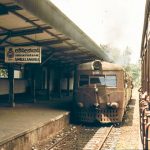The Lady Ridgeway Hospital for Children is situated in spacious environs in the Colombo suburb of Borella. The hospital’s architecture was of typical British colonial-style with red terracotta walls, ornate windows, and imposing colonnades, the columns interspersed with shade-giving tats that ensured a cool, surrounding corridor and interior. It serves as the national referral center for pediatric care in Sri Lanka. It also serves as a local pediatric hospital for the population in and around Colombo city for minor ailments.
It began when George Wall, a tea planter and philanthropist, discussed with Lady Havelock the innovative idea of creating a separate hospital for women and children. Enthused, Lady Havelock headed a committee to raise funds from the public, which amounted to 46,000 rupees. Consequently, on January 17, 1895, the Governor, Sir Arthur E. Havelock laid the foundation stone of what was to be called the Lady Havelock Hospital for Women and Children (LHH).

Lady Ridgeway
It took over a year to build, by which time Sir Arthur Havelock had been succeeded as Governor by Sir Joseph West Ridgeway, and so it was Lady Ridgeway who ceremonially opened the hospital on October 12, 1896.
A grand occasion supported by several local companies was planned, but, as the Sinhala daily newspaper Lakrivikirana reported:
The rain somewhat dampened the grandeur of the occasion, and some of the planned pageantry could not take place. Nevertheless a large gathering of distinguished persons graced the occasion
At exactly 4.30pm the Honourable Sir and Lady Ridgeway accompanied by their daughter arrived. A volunteer band struck up as they alighted from their vehicle and they were welcomed by Dr Kynsey (Principal Civil Medical Officer). Lady Ridgeway was presented with a memento of the occasion, a silver casket in which lay a silver key.
There followed a blessing by the Archdeacon of Colombo and an address by Dr Kynsey in which he explained how the hospital had come into existence mainly due to George Wall, who, alas, died before its completion. Lady Ridgeway conveyed how sad Lady Havelock was for being unable to attend and declared open the free-of-charge hospital, which was bedecked with ferns and flowers for the occasion.
The hospital was furnished and decorated by commercial sponsors, and the first matron was quoted as saying she had “never seen such a neatly fitted hospital”. There were four wards, each with six beds and two cots (the latter with red coverlets embroidered with the letters “LHH”), and six separate rooms for paying patients – 32 beds in total. The wards were named after donors who had contributed over 4,000 rupees, the separate rooms after donors who contributed over 1,000 rupees, and even some beds after donors who contributed over 500 rupees. It was truly a hospital by the people for the people.
Soon after the opening, Ceylon’s first nursing school was established at the hospital, of significance as this was just 18 years after Florence Nightingale had opened her school in London. It was run by a British matron, who Professor Senanayake believes may well have been trained by Nightingale as she was reported to have “a keen interest in the sanitary and health measures adopted in India and the colonies”.
Mention of “The Lady with the Lamp” makes it important to remember that Ceylon possesses a remarkable indigenous medicinal heritage: a herbal practice of medicine called Hela-Veda, hospitals before Rome, Egypt or China, kings who were dedicated physicians, and women who nursed wounded soldiers seven centuries before Nightingale. But then, as in all civilizations, there was a decline.
In a later, westernised era of medicine, the impressive LHH soon became crowded and understaffed, and problems arose because the children were not accommodated separately. So on February 26, 1909, the then Governor, Sir Henry McCullum, laid the foundation stone for the construction of a separate block for children funded once again by public subscription, on this occasion under the patronage of Lady Ridgeway. Opened on September 27, 1910, this new section was called the Lady Ridgeway Hospital (LRH), a two-storey building “with a majestic interior of decorative flooring, an ornate balustrade and a sweeping wooden staircase”.

Sir Henry McCallum 
Entrance to the Namasiwayam Memorial Ward 
Inscribed foundation stone of the Lady Ridgeway Hospital
Thus one hospital became two, creating the country’s first independent children’s hospital. However, it wasn’t until 1937 that a paediatrician was appointed, a major turning point for child care. After Independence in 1948 the Ministry of Health adopted plans to progressively reconstruct the LRH. The first wing of the new hospital containing new wards was opened in 1950 (the year the LRH acquired its first X-ray machine), the Outpatient Department (OPD) in 1957, the rest of the wards in 1961, and a new operating theatre in 1971.

Plan of LRH (1950s) 
Staff of the Lady Ridgeway and Havelock Hospitals, 1937
As for the Lady Havelock Hospital, it ceased to exist in 1954 when the nearby Castle Street Hospital for women opened. The remaining buildings were demolished in the mid-1990s to make way for a ten-storey wing funded by the Chinese government that was opened in 2000, increasing the number of beds from 700 to 1,100, apparently making it the world’s largest children’s hospital.
Credit – Explore Sri Lanka, Lady Ridgeway Hospital














Loading…
Loading…